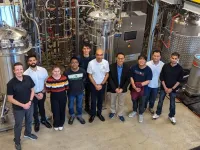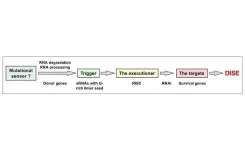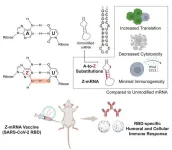(Press-News.org) The introduction of screening for type 2 diabetes in Accident and Emergency (A&E) departments could uncover thousands of previously undiagnosed cases every year, suggests new research being presented at this year’s Annual Meeting of The European Association for the Study of Diabetes (EASD), Hamburg (2-6 Oct).
“Early diagnosis is the best way to avoid the devastating complications of type 2 diabetes, and offers the best chance of living a long and healthy life”, says Professor Edward Jude, Tameside and Glossop Integrated Care NHS Foundation Trust, UK. “Symptoms of type 2 diabetes may be absent and can be tricky to spot in the early stages and the condition can go undetected for up to 10 years, which can lead to long-term complications such as heart disease, nerve damage and retinopathy.”
The study included 1,388 patients visiting the A&E department at Tameside and Glossop Integrated Care NHS Foundation Trustin England, all without a diabetes diagnosis and who were selected at random.
All patients were screened for type 2 diabetes using the glycated haemoglobin (HbA1c) test that gives an indication of average blood sugar (glucose) levels over the previous two to three months. Pre-diabetes was defined as HbA1c 39-47 mmol/mol and diabetes as 48 mmol/mol or higher.
Patients were also asked to complete a questionnaire about demographics, ethnicity, and risk factors for diabetes. This information was used to calculate each patient’s Finnish Diabetes Risk Score (FINDRISC) to identify those at risk of developing type 2 diabetes, with scores of more than 20 indicating a very high risk of developing diabetes (50% chance over 10 years) and scores of 12-20 indicating moderate to high risk (33% chance over 10 years) [1].
Of the 1,388 patients screened, 848 (61%) had normal blood glucose levels (average age 51 years, average HbA1c 34 mmol/mol, average weight 81kg and average BMI 28.4 kg/m²).
However, 420 individuals (30%) were found to have prediabetes (average age 57 years, average HbA1c 41 mmol/mol, average weight 82kg, and average BMI 28.6 kg/m²), putting them at risk of developing the condition.
A further 120 patients (9%) were diagnosed with type 2 diabetes, a similar proportion in men and women (average age 56 years, average HbA1c 51 mmol/mol, average weight 94kg and average BMI 31.2 kg/m²).
Importantly, people of South Asian and other ethnic backgrounds had a higher incidence of glucose intolerance compared to Caucasians (43% vs 38%) and were twice as likely to be diagnosed with prediabetes or diabetes.
Further analysis found that each unit increase in the FINDRISC score (above zero) was associated with a 7% increased risk for prediabetes and a 15% increased risk for type 2 diabetes, after adjusting for age and sex.
Based on the results, tens of thousands of cases of new cases of prediabetes and diabetes could be diagnosed in A&E departments across the country every year, say researchers.
“Opportunistic HbA1c-based screening in A&E departments, particularly those in high-risk and hard to reach groups, could make an important contribution to identifying undiagnosed individuals who will benefit from early treatment and lifestyle changes and so reduce their risks of long-term complications”, says Professor Jude. “Our findings suggest that the FINDRISC score could also be used to help ensure those at highest risk of developing type 2 diabetes are made aware of their risk.”
Despite the important findings, the authors noted some limitations to the study, including for example that the study was conducted at a single hospital and so the results may not be generalisable to other hospitals across England. In addition, for logistical reasons not all attending patients gave a blood sample.
Professor Edward Jude, Tameside and Glossop Integrated Care NHS Foundation Trust, UK. T) +44 790 0677 229 E) Edward.Jude@tgh.nhs.uk
Alternative contact in the EASD Press Room: Tony Kirby T) + 44(0)7834 385827 E) tony@tonykirby.com
Notes to editors:
[1] FINDRISC requires no laboratory testing and has been validated in multiple populations. FINDRISC uses age, BMI, physical activity, vegetable and fruit intake, medical treatment of high blood pressure, history of high blood sugar and family history to determine risk of developing diabetes.
EJ has received advisory board honoraria and grant/research support from Sanofi, and has received speaker honoraria from Bayer AG, Boehringer Ingelheim, Eli Lilly, Novo Nordisk, Menarini and Sanofi.
This press release is based on poster presentation 352 at the annual meeting of the European Association for the Study of Diabetes (EASD) in Hamburg. The material has been peer reviewed by the congress selection committee. There is no full paper at this stage, but the authors are happy to answer your questions.
For full abstract click here
For full poster click here
For slides that accompany abstract, click here
Dr Jude will also take part in the embargoed press conference taking place at 1200H Noon CEST Hamburg time on Tues 3 Oct, in the Vienna Hall.
To join by zoom, use this link
https://us06web.zoom.us/j/86523053998?pwd=0CxM4PetJCn8K6CbnavJVbp3uIZ3aa.1
END
Emergency department screening could detect thousands of undiagnosed prediabetes and diabetes cases, UK study suggests
Screening yielded an additional 9% of type 2 diabetes cases and 30% of prediabetes cases
2023-10-04
ELSE PRESS RELEASES FROM THIS DATE:
New stem cell-derived islet therapy improves blood sugar control in all treated patients, with three achieving insulin independence
2023-10-04
Six adults with type 1 diabetes (T1D) treated with stem cell-derived islet cells (VX-880) have shown improved blood sugar control with three participants achieving insulin independence, according to new research being presented at this year’s Annual Meeting of The European Association for the Study of Diabetes (EASD), Hamburg (2-6 Oct).
All patients treated with VX-880 have demonstrated improved glycaemic control, as evidenced by elimination of severe hypoglycaemia (low blood sugar), improvements in HbA1c (a measure of long-term sugar levels) and the amount of time their ...
New pipeline makes valuable organic acid from plants — saving money and emissions
2023-10-03
In a breakthrough for environmentally friendly chemical production, researchers at the Center for Advanced Bioenergy and Bioproducts Innovation (CABBI) have developed an economical way to make succinic acid, an important industrial chemical, from sugarcane.
The team of University of Illinois and Princeton University researchers created a cost-effective, end-to-end pipeline for this valuable organic acid by engineering a tough, acid-tolerant yeast as the fermenting agent, avoiding costly steps in downstream processing. Succinic acid is a widely ...
PARMESAN: An AI-based predictive tool to find new treatments for genetic disorders
2023-10-03
To discover new treatments for genetic disorders, scientists need a thorough knowledge of prior literature to determine the best gene/protein targets and the most promising drugs to test. However, biomedical literature is growing at an explosive rate and often contains conflicting information, making it increasingly time-consuming for researchers to conduct a complete and thorough review.
To address this challenge, Cole Deisseroth, a graduate student enrolled in the M.D./Ph.D. program and mentored by Drs. Huda Zoghbi and Zhandong Liu at the Jan and Duncan ...
PPPL awarded $5 million to lead an Energy Earthshot Research Center focused on clean hydrogen
2023-10-03
Lessening the effects of climate change will require a variety of innovations and a lot of ingenuity. Now, a new center led by the U.S. Department of Energy’s (DOE) Princeton Plasma Physics Laboratory (PPPL) will help these efforts by advancing the understanding of plasma-based clean hydrogen production.
PPPL was selected to lead a DOE Energy Earthshot Research Center (EERC) as part of the Hydrogen Shot™, which aims to reduce the cost of hydrogen by 80%. With funding from the DOE’s Office of Science, the EERCs support fundamental ...
Illinois-led project to sequence 400 soybean genomes, improve future crops
2023-10-03
As a source of protein and biodiesel for cleaner renewable energy, soybean is an important crop worldwide. But is it performing to its full potential? An ambitious effort led by the University of Illinois Urbana-Champaign and the U.S. Department of Energy Joint Genome Institute (JGI) will sequence 400 soybean genomes to develop a “pangenome” — an attempt to characterize all the useful diversity in the genome to create an even more robust and resilient crop.
The soybean pangenome project will sequence and analyze at least 50 soybean genomes from cultivated lines and wild relatives at reference quality, the gold standard of modern sequencing. A further ...
An ancient anti-cancer mechanism: DISE
2023-10-03
“DISE is effective against all cancers we tested.”
A new editorial paper was published in Oncotarget's Volume 14 on September 25, 2023, entitled, “DISE, an ancient anti-cancer mechanism that senses mutational load in cancerous cells?”
In their new editorial, researchers Monal Patel and Marcus E. Peter from Northwestern University discuss a recent breakthrough in cancer therapy. Despite the multiple advances in therapy, cancer remains one of the most common causes of death globally. ...
Project aims to develop all-in-one semiconductor that stores, processes data
2023-10-03
A multi-institutional project led by a Penn State researcher is focused on developing an all-in-one semiconductor device that can both store data and perform computations. The project recently received $2 million in funding over three years as part of the new National Science Foundation Future of Semiconductors (FuSe) program, a $45.6 million investment to advance semiconductor technologies and manufacturing through 24 research and education projects across the United States.
“The goal of ...
Nemours Children’s Health hosts first-ever pediatric session at HLTH
2023-10-03
Nemours Children’s Health will host the first-ever dedicated pediatric session at HLTH, the leading platform bringing together the entire health ecosystem focused on health innovation and transformation. This invited program, “Elevating Kids Health Well Beyond Medicine,” will extend HLTH’s 2023 theme, “Elevating Humanity,” to focus on health in childhood and why it is the only way to build good health across the lifespan.
“The child health perspective is an essential viewpoint for the attendees of HLTH to consider and we are proud to offer ...
OU Engineering among top 28 teams nationwide selected for DEPSCoR Grant
2023-10-03
University of Oklahoma engineering researcher Reza Foudazi, Ph.D., has been selected to receive a $600,000 grant from the U.S. Department of Defense under the Defense Established Program to Stimulate Competitive Research, or DEPSCoR. The highly competitive grant was awarded to only 28 academic teams nationwide.
An associate professor in the School of Sustainable Chemical, Biological and Materials Engineering, Foudazi’s research centers on the exploration of electrochemical energy storage systems that incorporate multivalent ions. ...
From A to Z: An alternative base modification for mRNA therapeutics
2023-10-03
Messenger RNA (mRNA) technology has become popular in the last few years due to its use in COVID-19 vaccines. This technology has been so groundbreaking that it recently won the 2023 Nobel Prize in medicine “for discoveries concerning nucleoside base modifications that enabled the development of effective mRNA vaccines against COVID-19.” This isn’t new technology, however— modified mRNAs have been studied for decades and show significant potential for therapeutic applications. Compared to unmodified mRNAs, modified ...
LAST 30 PRESS RELEASES:
Ribosomal engineering creates “super-probiotic” bacteria
This self-powered eye tracker harnesses energy from blinking and is as comfortable as everyday glasses
Adverse prenatal exposures linked to higher rates of mental health issues, brain changes in adolescents
Restoring mitochondria shows promise for treating chronic nerve pain
Nature study identifies a molecular switch that controls transitions between single-celled and multicellular forms
USU chemists' CRISPR discovery could lead to single diagnostic test for COVID, flu, RSV
Early hominins from Morocco reveal an African lineage near the root of Homo sapiens
Small chimps, big risks: What chimps show us about our own behavior
We finally know how the most common types of planets are created
Thirty-year risk of cardiovascular disease among healthy women according to clinical thresholds of lipoprotein(a)
Yoga for opioid withdrawal and autonomic regulation
Gene therapy ‘switch’ may offer non-addictive pain relief
Study shows your genes determine how fast your DNA mutates with age
Common brain parasite can infect your immune cells. Here's why that's probably OK
International experts connect infections and aging through cellular senescence
An AI–DFT integrated framework accelerates materials discovery and design
Twist to reshape, shift to transform: Bilayer structure enables multifunctional imaging
CUNY Graduate Center and its academic partners awarded more than $1M by Google.org to advance statewide AI education through the Empire AI consortium
Mount Sinai Health system receives $8.5 million NIH grant renewal to advance research on long-term outcomes in children with congenital heart disease
Researchers develop treatment for advanced prostate cancer that could eliminate severe side effects
Keck Medicine of USC names Christian Pass chief financial officer
Inflatable fabric robotic arm picks apples
MD Anderson and SOPHiA GENETICS announce strategic collaboration to accelerate AI-driven precision oncology
Oil residues can travel over 5,000 miles on ocean debris, study finds
Korea University researchers discover that cholesterol-lowering drug can overcome chemotherapy resistance in triple-negative breast cancer
Ushikuvirus: A newly discovered giant virus may offer clues to the origin of life
Boosting the cell’s own cleanup
Movement matters: Light activity led to better survival in diabetes, heart, kidney disease
Method developed to identify best treatment combinations for glioblastoma based on unique cellular targets
Self-guided behavioral app helps children with epilepsy sleep earlier
[Press-News.org] Emergency department screening could detect thousands of undiagnosed prediabetes and diabetes cases, UK study suggestsScreening yielded an additional 9% of type 2 diabetes cases and 30% of prediabetes cases





